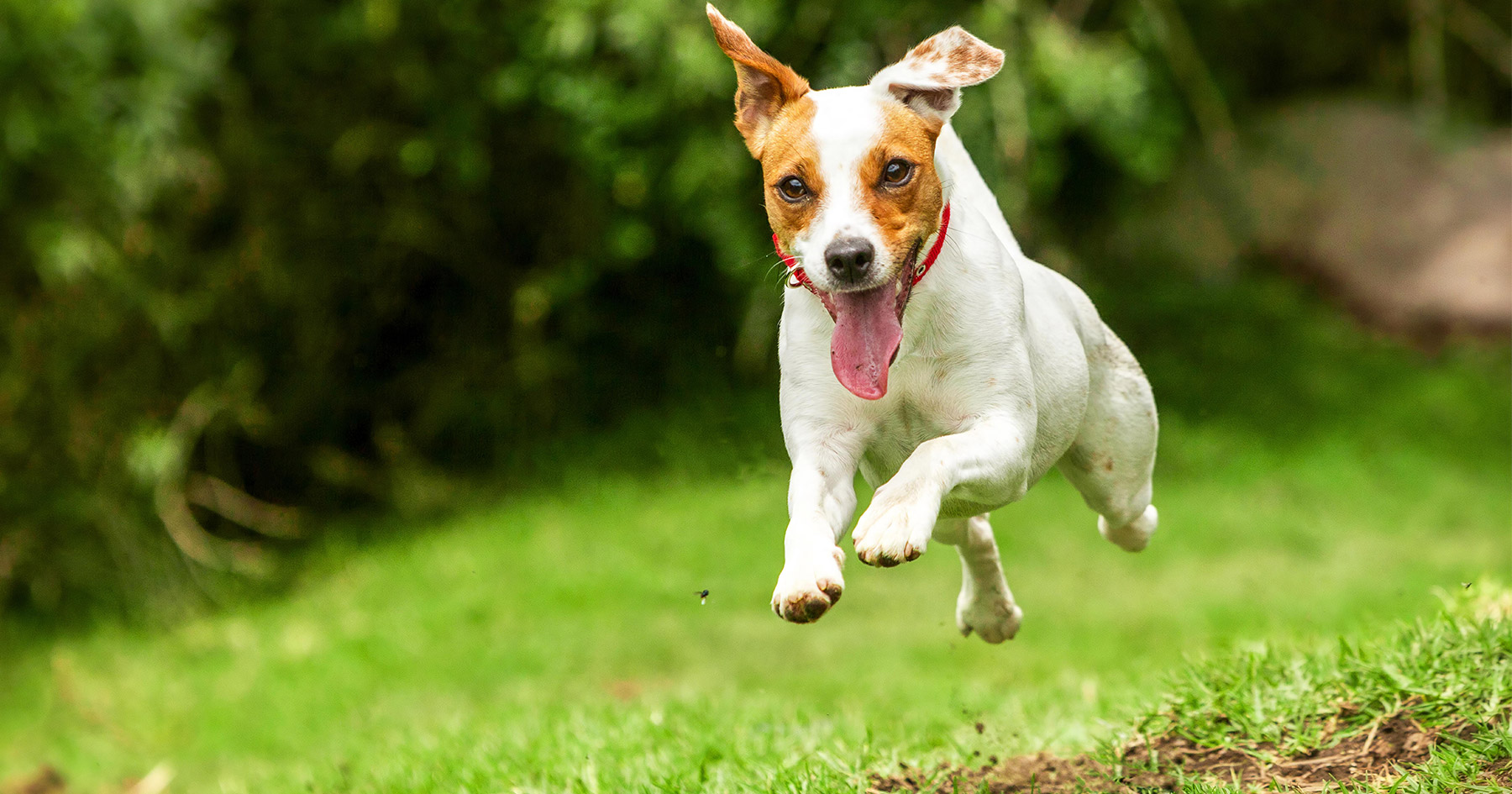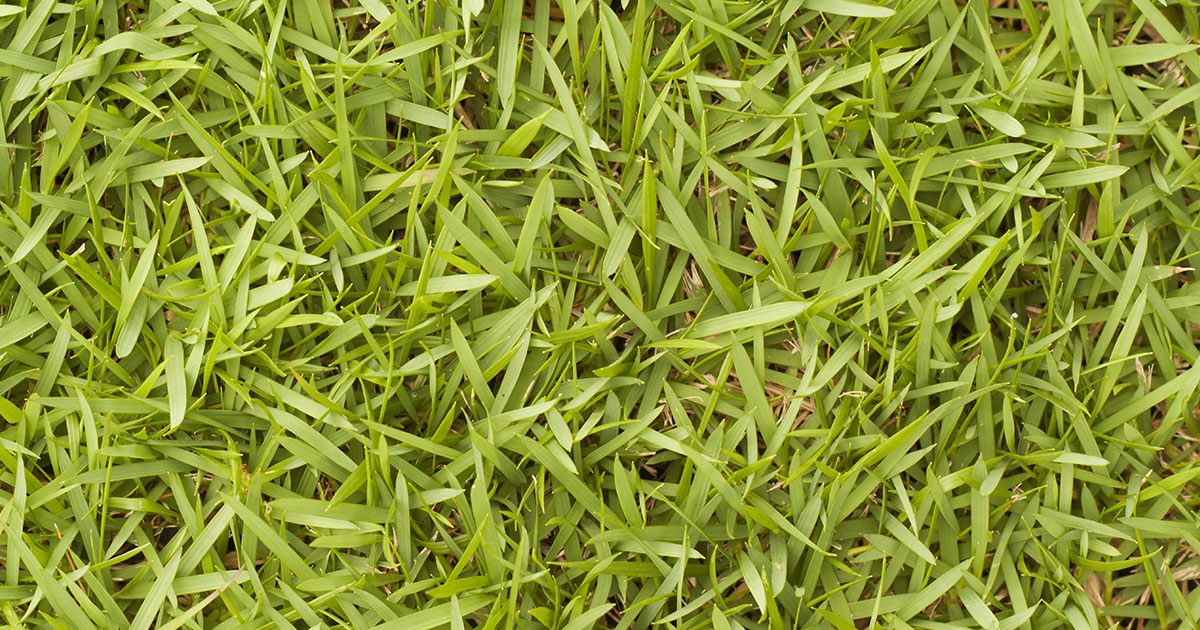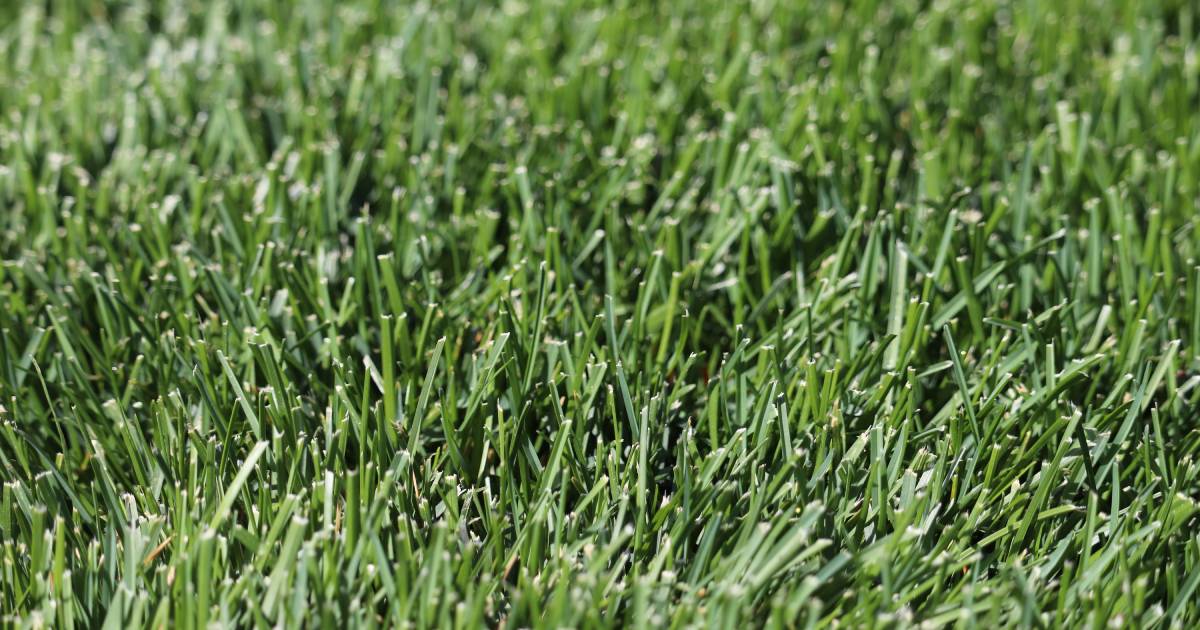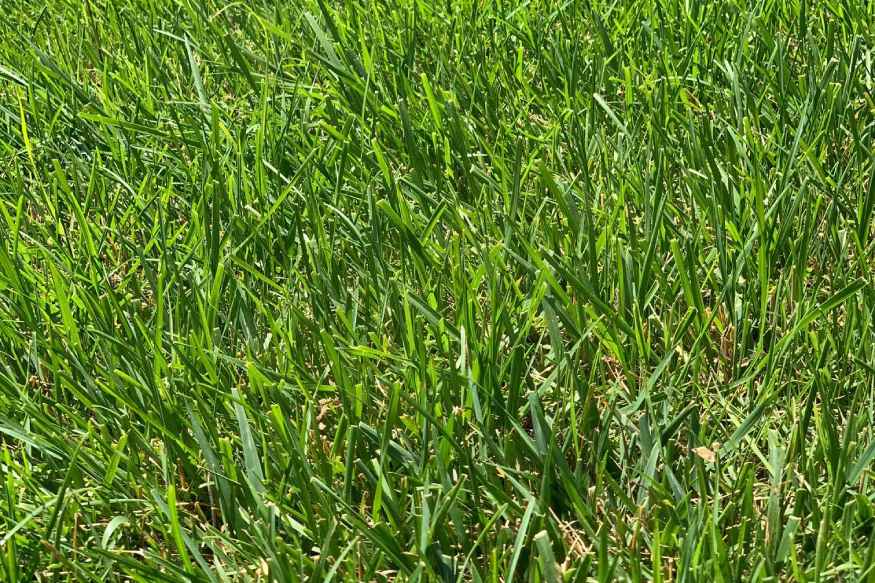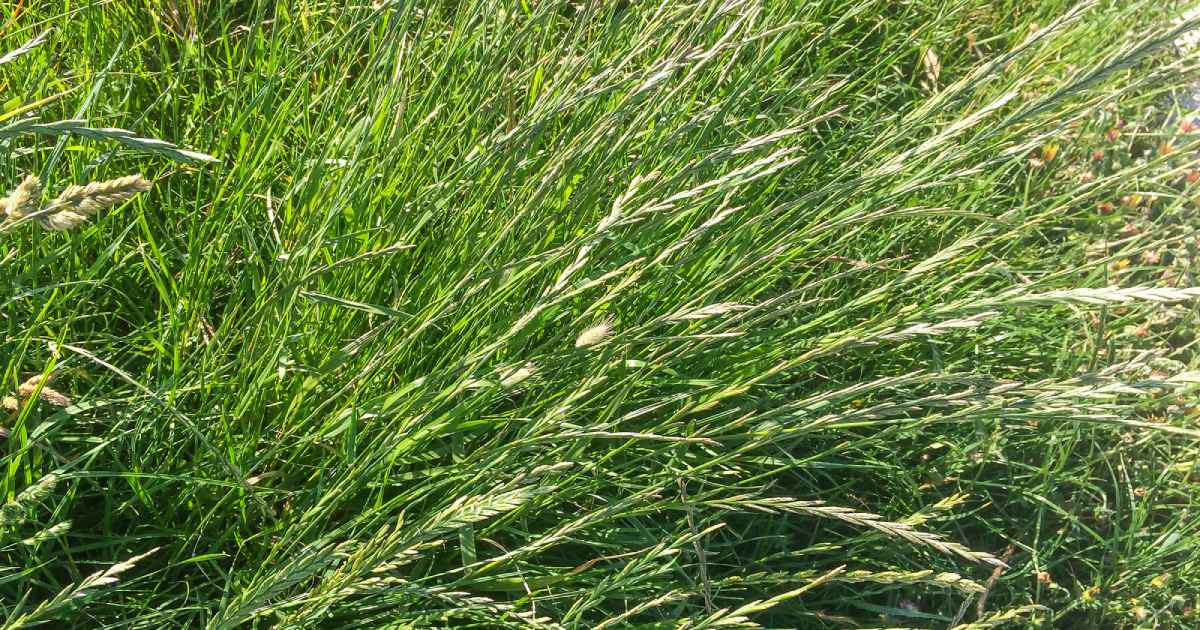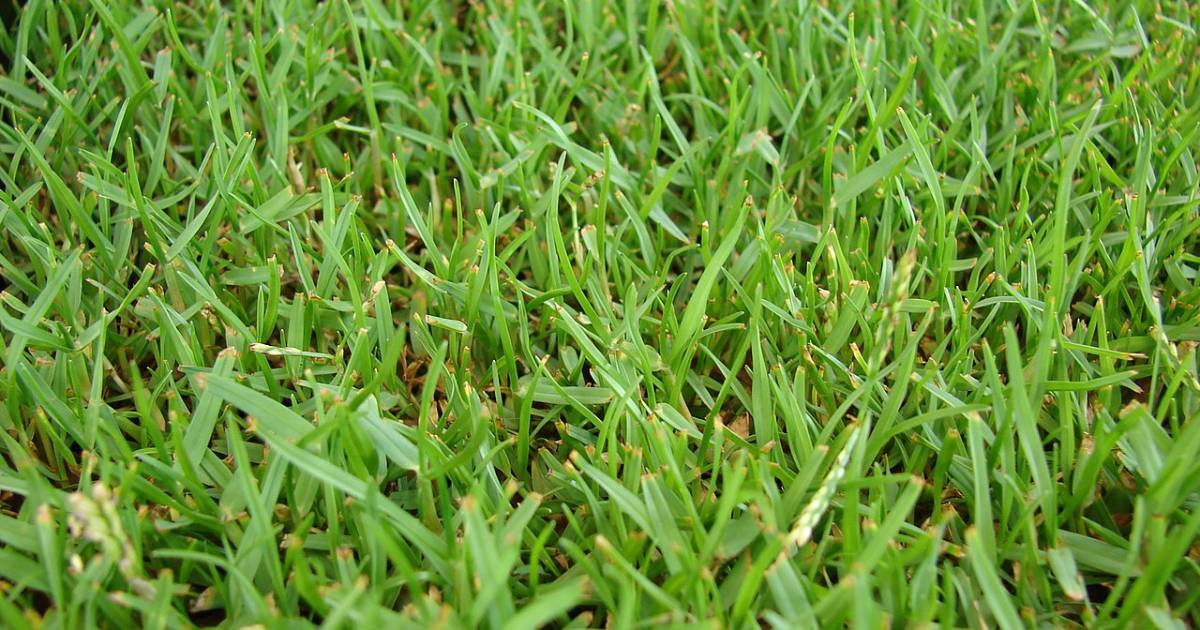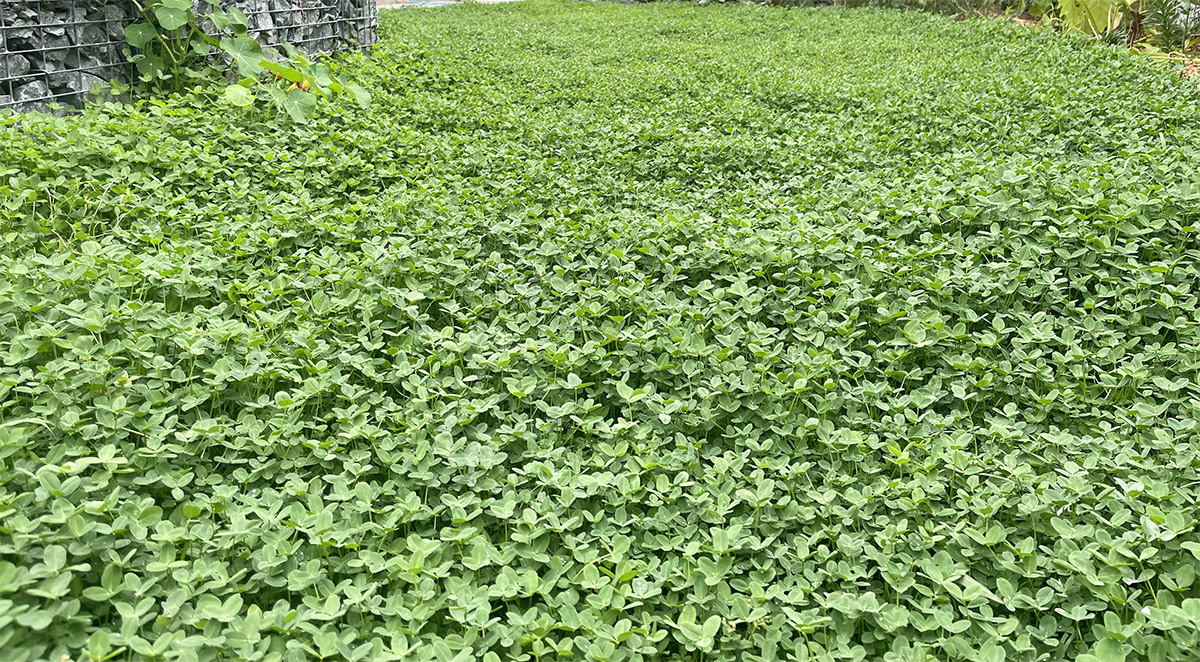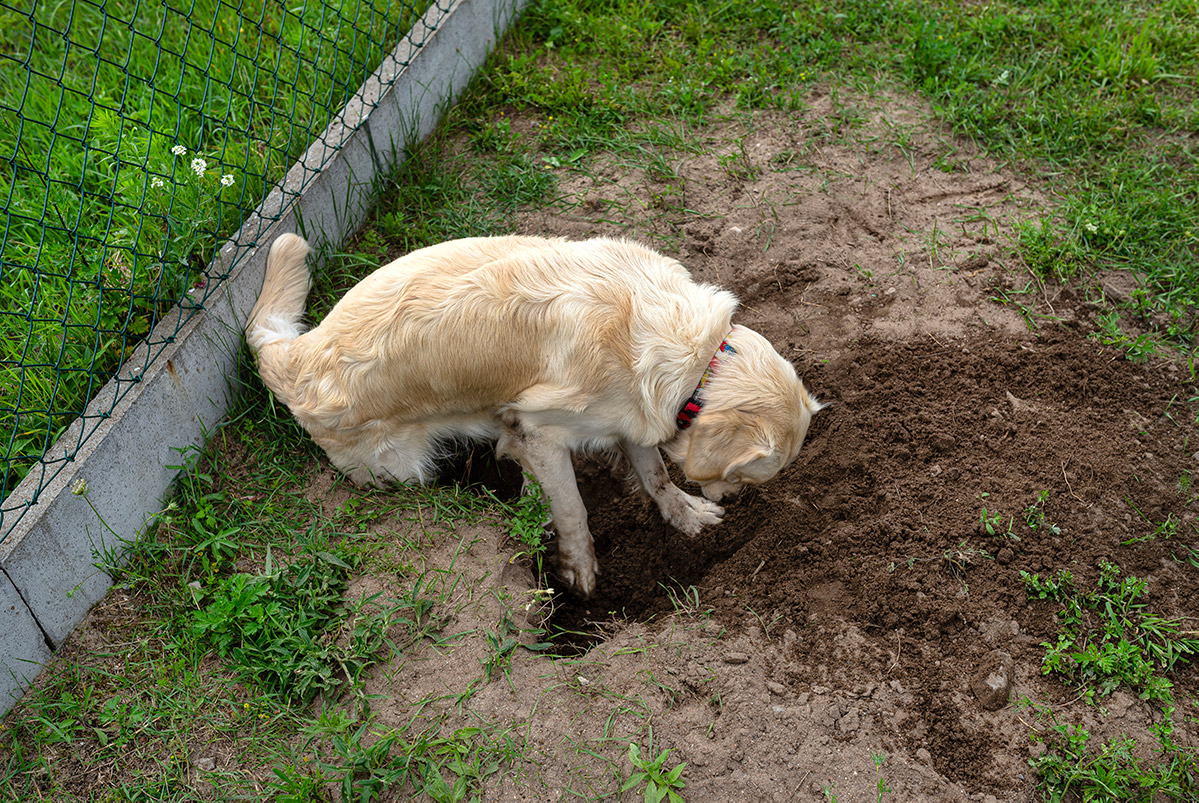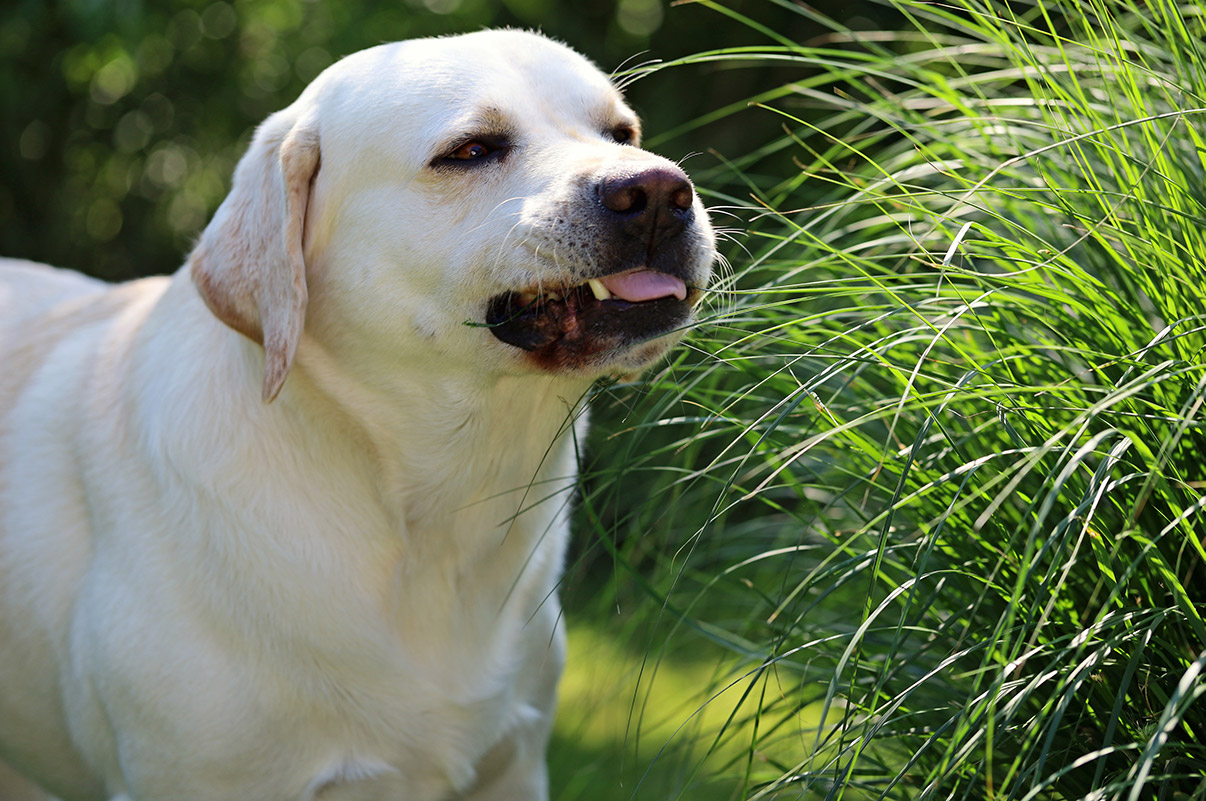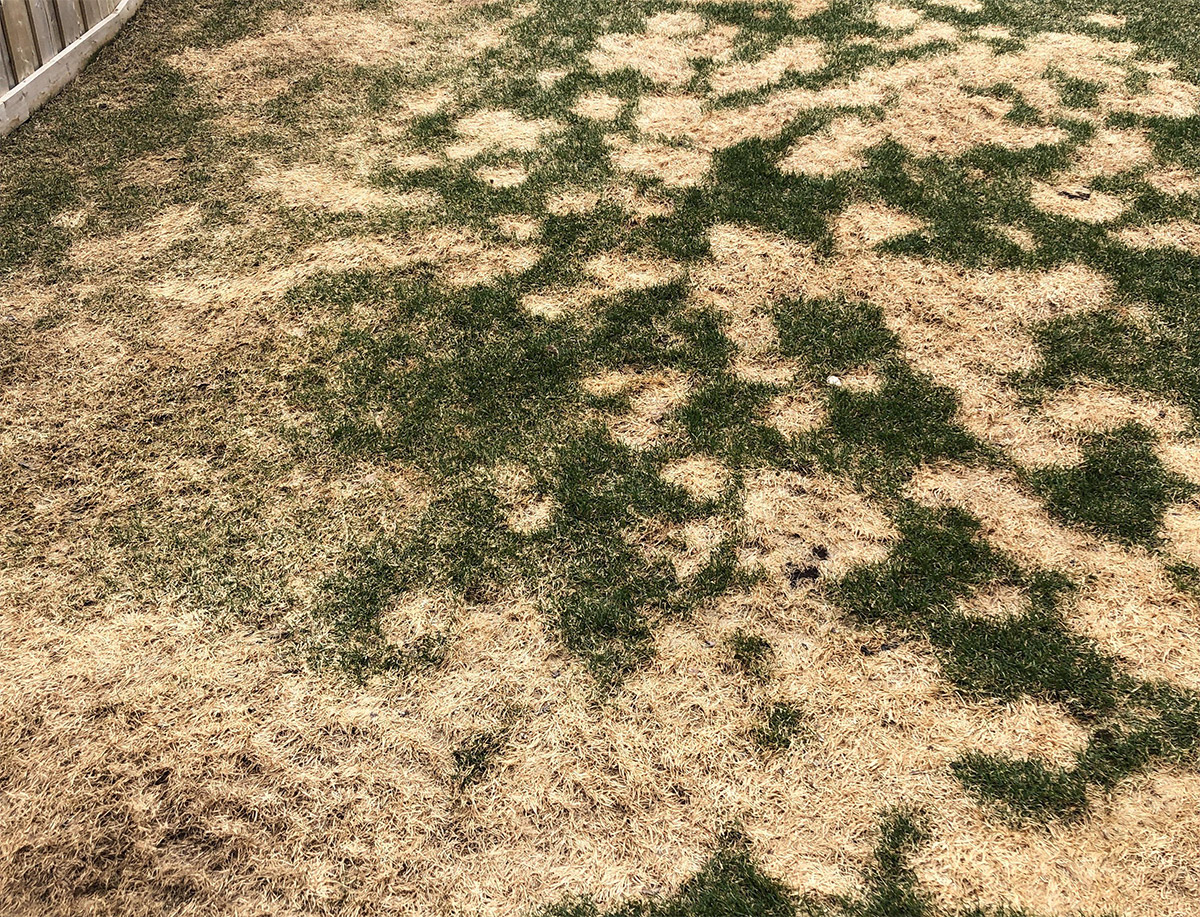Are you struggling to keep your lawn looking great due to damage caused by your dog? You aren’t alone.
Between urine burn, digging holes, and eating grass, dogs can be pretty hard on lawn. But you can avoid some of this damage by choosing a durable species of grass to use for your pet-friendly yard.
In this article, we’ll look at six types of grass that hold up better to doggy damage than others. We’ll walk through the pros and cons of each to determine the best grass for dogs in your region, talk about why dogs are so hard on lawns, and provide some tips to help reduce damage.
[ez-toc]
The Best Grass Types for Dogs
When we set out to find the best grass varieties for dogs, we considered multiple characteristics.
First, we looked at each grass’s durability. Not only were we interested in which species could tolerate a high amount of foot traffic and friction, but we also looked at which regrows the fastest after sustaining damage.
Then we looked at each grass’s tolerance for urine. While some species burn with even the slightest contact with concentrated urine, others react to urine as if it were a fertilizer.
We also took factors such as drought tolerance, disease resistance, and watering needs into consideration. All of these play into a grass’s overall durability as well as its maintenance needs.
Here are the top six best grasses for pet owners.
Bermuda Grass
| Also Known As | Bermuda grass, wiregrass; Cynodon dactylon L. |
| Type of Grass | Warm season perennial |
| Optimal Zones | Southern region |
| Root Structure | Deep |
| Winter hardiness | Poor |
| Heat tolerance | Excellent |
| Shade tolerance | Poor |
| Water Requirements | High |
| Drought Tolerance | High |
| Urine Tolerance | Poor |
| Self Repair Capacity | Excellent |
| Overall Maintenance Requirements | Moderate to High |
When well maintained, Bermuda grass forms dense turf with an incredibly high tolerance for foot and paw traffic. When damage does occur, such as from digging or dogs tearing across it on a rainy day, it tends to repair itself very quickly thanks to aggressively growing stolons and rhizomes. In fact, this grass has the most rapid growth rate of any common turfgrass.
Additionally, this popular choice has a high drought tolerance and does very well with heat. It needs less maintenance than other grasses but looks and performs its best with plenty of fertilizer and consistent watering and mowing.
The one downside to using Bermuda grass for dog yards is that it is very sensitive to urine. Even a small amount of concentrated urine will cause visible burns. Compared to other species, however, these burns will repair themselves quite quickly if given the chance.
In speaking with dog owners who have Bermuda grass lawns, we found most were very happy with their choice. They did mention urine burns were a frequent issue but that cutting the grass short to force rhizome growth and providing enough water kept the burns from sticking around.
Bermuda grass is a warm-season grass that grows particularly well in tropical and subtropical regions. It requires full sun and will invade flower beds if not kept in check.
Bermudagrass is a great choice for dog owners in southern climates looking for very durable grass to cover large yards that are less likely to experience repeated urination in the same spots.
Kentucky Bluegrass
| Also Known As | Poa pratensis L. |
| Type of Grass | Cool season perennial |
| Optimal Zones | Northern cool season zone, transition zones |
| Root Structure | Shallow |
| Winter hardiness | Excellent |
| Shade tolerance | Poor to Good |
| Water Requirements | High |
| Drought Tolerance | Poor |
| Urine Tolerance | Poor |
| Self Repair Capacity | Excellent |
| Overall Maintenance Requirements | High |
Kentucky bluegrass provides a lush, deep green lawn that homeowners and dogs tend to love. It is tolerant of moderate traffic but has an excellent self-repair capacity when it gets more wear than it can handle. This is thanks to aggressive, below-ground rhizomes that move in quickly to fill bare spots.
On the downside, Kentucky bluegrass is very sensitive to urine. It will turn yellow with even the slightest exposure to concentrated urine. Like Bermudagrass, it will repair the spot quickly if given the chance, however.
Kentucky bluegrass doesn’t do well with drought and requires frequent fertilization and mowing, and needs a lot of water. It does, however, do well in colder climates and can withstand freezing temperatures through the winter.
Most dog owners we spoke to who had Kentucky bluegrass were happy with their choice. Smaller yards with active dogs fared worse than larger ones and all suffered from urine burn problems. However, just like with bermudagrass, owners noted these burns only last a short time before filling themselves in.
Kentucky bluegrass is a cool-season species and grows best in northern climates that experience mild summers. It does not fare well in heat and requires a large amount of water to stay lush and green.
For dog owners with large yards and the budget and time to care for it, Kentucky bluegrass is a great choice.
Tall Fescue
| Also Known As | Lolium arundinaceum (formerly Festuca arundinacea) |
| Type of Grass | Cool season perennial |
| Optimal Zones | Northern through transition zones |
| Root Structure | Deep |
| Winter hardiness | Excellent |
| Shade tolerance | High |
| Water Requirements | Medium to High |
| Drought Tolerance | Excellent |
| Urine Tolerance | High |
| Self Repair Capacity | Limited |
| Overall Maintenance Requirements | Low |
Tall fescue is the most popular lawn grass in the US and is a great choice for pet owners. It has a high traffic tolerance and is perfect for dogs who like to run zoomies. Even better, it is much less sensitive to urine than most grass species.
According to the University of Missouri, tall fescue is the most urine-resistant turf-grass variety. It will burn with highly concentrated urine but is unaffected by more dilute samples. In fact, dilute urine has a fertilizer effect, causing the grass to green up and grow faster where urine is deposited.
Tall fescue is also a very easy keeper, requiring infrequent fertilization while being very tolerant of heat, cold, and drought.
The one major drawback of tall fescue is that it has limited self-repair capacity. It does produce some rhizomes. But has more of a bunch-style growth habit.
This means that if damage occurs from digging or excessive chewing or play, you will have to reseed or patch the area.
Most dog owners we talked to with tall fescue grass noted that the grass does tend to grow longer and greener where their dog uses the bathroom. One recommended mixing tall fescue with clover when using in small yards where urine burns have been a problem. Overall, they were pleased with their lawns’ durability and low maintenance needs.
Tall fescue is a cool-season grass that grows best in northern and transition zones. However, some cultivators do well as far south as the Mexican border.
This grass type makes a great option for dog owners with small and large yards.
Perennial Ryegrass
| Also Known As | Lolium perenne L. |
| Type of Grass | Cool season perennial |
| Optimal Zones | Mild northern zones |
| Root Structure | Deep |
| Winter Hardiness | Good to excellent |
| Shade Tolerance | Moderate |
| Water Requirements | High |
| Drought Tolerance | Good |
| Urine Tolerance | High |
| Self Repair Capacity | Excellent wear tolerance |
| Overall Maintenance Requirements | Moderate to high |
Next to tall fescue, perennial ryegrass is the next best choice for dealing with urine burns. This grass is highly tolerant of dilute urine and will respond by greening up and growing faster in these areas. Concentrated urine may cause damage, but this grass is much less sensitive to it than other options.
Another great plus for dog owners is that this hardy grass tolerates heavy foot traffic. It does not damage easily under doggy paws. It is also fairly tolerant of drought.
On the downside, perennial ryegrass has a bunching growth habit which means it is not capable of repairing itself. If damage does occur through hole digging or excessive urination, you will have to patch or reseed the area.
Perennial ryegrass is also less tolerant of harsh winters and hot summers compared to other options.
Dog owners with perennial ryegrass were overall very satisfied with their choice. Similar to tall fescue, they noted greener areas where their dog frequently uses the bathroom and high durability in the face of doggy zoomies.
Perennial ryegrass is a cool-season grass that grows best in northern cooler climates and transition zones that experience mild summers.
For dog owners, it is a great option for large and small yards. Just be prepared to have to manually fill in areas if damage does occur.
Zoysia Grass
| Also Known As | Zoysiagrass; Zoysia sp. |
| Type of Grass | Warm season perennial |
| Optimal Zones | Southern through warmer transition zones |
| Root Structure | Shallow to medium |
| Winter Hardiness | Good |
| Heat Tolerance | Excellent |
| Shade Tolerance | Partial |
| Water Requirements | Medium |
| Drought Tolerance | Good |
| Urine Tolerance | Good |
| Self Repair Capacity | Low |
| Overall Maintenance Requirements | Moderate |
Zoysia is a highly durable grass that is also drought-tolerant and disease and weed resistant. For dog owners, opting for zoysia is likely to free up your weekends to give you more time to spend with Fido and less time caring for your lawn.
Another major plus of this grass is that it is incredibly soft. Fine zoysia varieties have very thin grass blades that feel like heaven on your feet (or paws). If you like to sit in the yard and give your pup belly rubs, this is a great choice.
But zoysia isn’t without its pitfalls. Most notably, it is very slow to establish and takes a long time to repair itself when damage is done. Additionally, it needs extra care during drought and extreme heat and will turn yellow in the winter.
The dog owners we spoke to were quick to note how great this grass feels. They also mentioned how well it tolerates heavy foot traffic from people and pets. Most noted some damage from urine burns but said these eventually go away on their own.
Zoysia is a warm-season grass that grows best in southern zones and transition zones with warmer climates. It handles partial shade better than most other warm-season options.
We recommend zoysia for dog owners with medium to large yards where wear is a concern but urine damage is less likely.
Clover
| Type of Grass | Cool Season |
| Optimal Zones | Northern and transition zones |
| Root Structure | Deep-rooted |
| Winter Hardiness | Good |
| Heat Tolerance | Poor to fair |
| Shade Tolerance | Excellent |
| Water Requirements | Moderate |
| Drought Tolerance | High |
| Urine Tolerance | Excellent |
| Self Repair Capacity | High |
| Overall Maintenance Requirements | Low |
If you’re willing to try a turf alternative to solve your doggy lawn problems, clover is an excellent choice.
Clover has a moderate traffic tolerance, putting up with most of what the average dog can throw down. Even better, it has a high self-repair capacity in case of damage. Dense root structure and frequent self-reseeding mean this grass alternative fills in bare spots quickly.
This option is also drought tolerant and has very low maintenance needs. Because clover fixes its own nitrogen, it does not require fertilization. It also grows low, which means less mowing, and it does well in partial shade or full sun.
Best of all for dog owners, clover is not affected by dog urine, which means no more unsightly yellow urine spots.
There aren’t many downsides to clover lawns other than they don’t look like traditional grass. But they are soft, easy to walk on, and your dog likely won’t notice a difference.
The dog owners we spoke to who have made the transition to all or part-clover lawns were very satisfied. Once the lawn is established it is very resistant to dog damage and fills in quickly when problems do occur.
Clover comes in many types that can be planted throughout the US. These lawns do especially well in regions with mild winters but are cold hardy down to -35 degrees. They may not hold color through the winter in northern zones but they will typically come back in the spring.
For dog owners, clover is a great choice for yards large and small, especially if you’re looking for a low-maintenance, environmentally-friendly lawn option.
Why Do Dogs Damage and Eat Grass?
It may be hard to believe sometimes, but dogs don’t damage grass on purpose. Most often, the behaviors they perform that end up causing problems come from a place of instinct or boredom.
Below, we take a closer look at common dog behaviors that cause damage to grass, why they occur, and what you can do to minimize them.
Digging Up Grass
Digging is one of the most damaging things dogs can do to lawns. Even the most durable grasses are no match for a terrier with a mission to dig to China.
So why do dogs dig in grass?
Digging is often a matter of instinct. Terriers, especially, are prone to digging because this is what we have bred them to do.
Dogs will dig in pursuit of rodents, bugs, and even imaginary prey. The latter becomes a common issue for dogs who are bored and have nothing else to stimulate them.
Dogs will also dig in lawns and flower beds as a means to cool off. Dirt, especially if it’s wet, is much cooler than the grass on top. And a dog desperate for relief won’t hesitate to dig down to get to it.
So how do you help curb digging behavior?
If your dog is digging because they’re bored, try increasing how many walks they get per day or invest in a dog walker to help tire them out. You can also try providing more toys, especially mental stimulation toys that use hidden treats to keep Fido’s attention.
If you have a terrier or a dog that simply loves to dig, try building a sandbox or designated digging zone. Bury toys and treats inside to encourage digging here instead of in the grass.
For dogs that are digging to cool down, try providing a cool, shaded spot for them with a dog bed and a big bowl of water. Some dogs may even enjoy their own kiddy pool for cooling down.
If you have a dog prone to digging, we recommend investing in a grass variety with a high self-repair capacity. Bermuda grass, Kentucky bluegrass, and clover are all great choices.
Eating Grass
It isn’t entirely understood why dogs eat grass, but there are plenty of theories out there.
Many dogs seem to eat grass when their stomachs are upset. This can happen when they are on a low-quality diet, when their stomach gets too empty between meals, or when they have underlying health problems.
Some dogs may eat grass out of curiosity or boredom. Dogs with pica, a condition that causes them to eat inedible objects, may gorge on grass.
While eating grass isn’t likely to cause lasting damage to your lawn, it isn’t great for your dog.
Eating grass often leads to vomiting and digestive upset. But more worrisome is that eating grass can expose your dog to pesticides, herbicides, and other chemicals that can cause serious health problems.
If your dog is constantly eating grass, a trip to the vet is in order. You may also want to try changing their diet. A high-quality diet that contains plenty of protein from animal sources and minimal fillers is best.
If they come back from the vet with a clean bill of health and are still gorging on greens despite an improved diet, boredom may be the problem. Try increasing their exercise and offering stimulating toys while they’re in the yard.
Keeping your grass short can also help curb grass eating since dogs tend to target longer blades. If the problem persists, you may have to put a basket muzzle on your dog while they are outdoors. These muzzles allow your pup to drink and pant, but make it harder for them to eat things they aren’t supposed to.
Zoomies
Often, dogs do the most damage when they are on the move.
Sprinting around on the lawn—known in the dog world as “running zoomies”—can tear up the grass and leave muddy areas. The best way to keep your dog from damaging your grass in this way is to provide plenty of other outlets for activity. These include walks, time at the dog park, doggie daycare, and a good game of fetch at the park.
Zoomies tend to do the most damage when the grass is wet. Try keeping your dog off the lawn in the mornings and after precipitation.
If you have a zoomie-prone dog, we recommend planting turf that is resistant to wear. The best options include perennial ryegrass, bermudagrass, and zoysia.
Dog Urinating on Grass
Dog urine contains ammonia. When this compound is deposited on your lawn in high concentrations, it kills the blades and leaves them yellow. This is the same thing that can happen when you use certain high-nitrogen fertilizers, especially when it is hot out.
While you can’t stop your dog from peeing, there are some things you can do to stop that pee from burning your lawn.
The easiest is to spray your grass with water after your dog relieves themselves. This dilutes the ammonia to prevent scalding. Alternatively, you could train your dog to only pee in areas of your yard that have mulch or rocks.
If you have a urine-resistant lawn, you only have to worry about urine spots when your dog’s pee is very concentrated. This is generally only the case in the morning or when your dog has been locked inside for a long period. By walking your dog to relieve themselves at this time instead of letting them into the yard, you can avoid urine spots.
There are also many products and supplements on the market that claim to reduce urine burn. While users have mixed reviews on these, they may be worth a try.
If you are constantly dealing with yellow spots on your lawn, we recommend investing in grass that is less sensitive to ammonia. Tall fescue, perennial ryegrass, and clover are all great choices.
How to Maintain a Dog-Friendly Lawn
While dogs may be tough on lawns, the fact is, there are many benefits to having grass in your yard if you own a dog. Not only is it aesthetically pleasing to human family members, but it is a safe option for your pup.
Unlike gravel or bark, grass provides a soft surface for your dog to play and lounge on. And, even though they may eat it on occasion, it is much less likely to cause problems than if they eat other types of landscaping material.
While it may be hard for you to believe right now, it is possible to have a beautiful lawn and a happy dog that gets to enjoy it. The trick is to find the right grass to stand up to what your dog puts out and to maintain it properly. This means:
- Follow a lawn maintenance schedule to make sure your lawn gets everything it needs to thrive.
- Fertilize only as needed using a pet-safe organic fertilizer.
- Water deeply as often as your grass type requires to promote deep root growth.
- Mow regularly to ensure healthy, lush growth and to reduce your dog’s temptation to grab a grassy snack.
- Aerate annually to alleviate soil compaction problems caused by heavy traffic.
- Reduce urine burn by having your dog relieve themselves elsewhere in the morning or by spraying off the grass after they finish their business.
- Deal with weeds by pulling them or using a pet-safe pre-emergent herbicide or spot treatment.
- Address disease as soon as your lawn shows the first signs of trouble.
Additionally, be sure to help your lawn recover from pet damage by repairing brown spots, dead grass, and lawn burn quickly.
For grass with the capacity to self-repair, this means mowing it short to entice rhizome growth. Ensuring the damaged area is prepped for grass by applying a little topsoil and fertilizer while controlling weeds can also help.
For grass that does not repair itself quickly, be sure to put down grass seed, plant grass plugs, or lay sod over damaged areas as soon as they occur. Protect the area from your dog until it is well established. And reference the section above to see tips on how to avoid damage in the future.
The best grass for dogs depends on your region and what kind of damage you are struggling with. By picking the right type of grass for your needs from our list above, applying our tips to reduce damage, and following our recommendations for lawn care, you and your dog can enjoy a lush, healthy lawn for years to come.
